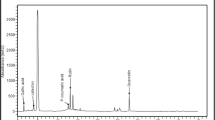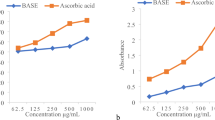Abstract
Cumin is one of the commonly used spices in food preparations. It is also used in traditional ayurvedic medicine as a stimulant, carminative and astringent. Earlier we have reported that bitter cumin (Cuminum nigrum L.) possess the most potent antioxidant activity among cumin varieties—cumin, black cumin and bitter cumin. In this study, we have further characterized the polyphenolic compounds of bitter cumin and also their antioxidant and antibacterial activity using different model systems. The major polyphenolic compounds of cumin seeds were extracted with 70% methanol, 70% acetone, water, separated by HPLC and their structures were elucidated by LC-MS. The profile of phenolic acids/flavonols in bitter cumin were found to be gallic acid, protocatechuic acid, caffeic acid, ellagic acid, ferulic acid, quercetin and kaempferol. The antioxidant activity of the cumin extract was tested on 1,1-diphenyl-2-picryl hydrazyl (DPPH) free radical scavenging, soybean lipoxygenase-dependent lipid peroxidation, rat liver microsomal lipid peroxidation and superoxide anion (O2−) scavenging. The bitter cumin extract exhibited high antioxidant activity with IC50 values of 14.0±0.5 μg, 28.0±3.0 μg, 110±14.0 μg and 125.4±8.7 μg of the extract, respectively for DPPH free radical scavenging, soybean lipoxygenase-dependent lipid peroxidation, rat liver microsomal lipid peroxidation and superoxide anion scavenging. Further, the extract offered a significant protection against DNA damage induced by hydroxyl radicals. Among a spectrum of food-borne pathogenic and spoilage bacteria tested, the cumin extract significantly inhibited the growth of Bacillus subtilis, Bacillus cereus and Staphylococcus aureus. Thus, bitter cumin with an array of polyphenolic compounds possesses potent antioxidant and antibacterial activities.






Similar content being viewed by others
References
Valentao P, Fernandes E, Carvalho F, Andrade PB, Seabra RM, Bastos MD (2002) Biol Pharm Bull 25:1320–1323
Gulcin I, Oktay M, Kirecci E, Kufrevioglu OI (2003) Food Chem 83:371–382
Kirtikar KR (1918) In: Basu BD, Basu LM (eds) Indian medicinal plants. pp 1201–1203
Thippeswamy NB, Naidu KA (2005) Eur Food Res Technol 220:472–476
Slinkard K, Singleton VL (1977) Am J Enol Viticul 28:49–55
Bondet V, Brand-Williams W, Besset C (1977) Food Sci Technol 30:609–615
Nishikimi M, Rao NA, Yagi K (1972) Biochem Biophys Res Commun 46:849–853
Lowry OH, Rosebrough NJ, Farr A, Randall RJ (1951) J Biol Chem 143:265–271
Buege JA, Aust ST (1978) Methods Enzymol 2:302–310
Shobana S, Naidu KA (2000) Prostaglandins Leukot Essent Fatty Acids 62:107–110
Madsen HL, Bertelsen G, Skibsted LH (1996) In: Risch SJ, Chi-Tang H (eds) Spices: flavour chemistry and antioxidant properties. American Chemical Society, New York, pp 176–187
Sanchez-Moreno C (2002) Food Sci Technol Inter 8(3):121–137
Yamaguchi T, Takamura H, Matoba T, Terao J (1998) Biosci Biotechnol Biochem 62:1201–1204
Stief TW (2003) Med Hypotheses 60:567–572
Yagi K (1987) Chem Phys Lipids 45:337–341
Finkel P, Holbrook NJ (2000) Nature 408:239–247
Boff I, Min DB (2002) Comp Rev Food Sci 1:58–72
Ashok B, Ali R (1999) Exp Gerontol 34:293–303
Takahama U (1985) Phytochemistry 24:1443–1446
Torel C, Cillard J, Cillard P (1986) Phytochemistry 25:383–385
Yang GC, Yasaei PM, Page SW (1993) J Food Drug Anal 1:357–364
Ames BN, Shigenga MK, Hagen TM (1993) Proc Natl Acad Sci USA 90:78–83
Sivapoulou A, Papanikolaou E, Nikolaou C, Kokkini S, Lanaras T, Arsenakis M (1996) J Agric Food Chem 4:1202–1205
Naganawa R, Iwata N, Ishikawa K, Fukuda H, Fujino T, Sujuki A (1996) Appl Environ Microbiol 62:4238–4242
Ferrell JE, Chang-Sing PD, Loew G, King R, Mansour JM, Mansour TE (1979) Mol Pharmacol 16:556–562
Melts ML, MacGregor JT (1981) Mutat Res 88:317–324
Mori A, Nishino C, Enoki N, Tawata S (1987) Phytochemistry 26:s2231–s2234
Acknowledgements
Authors are thankful to Dr. V. Prakash, Director and Dr. S.G. Bhat, Head of the Department of Biochemistry and Nutrition, Central Food Technological Research Institute, Mysore for their constant encouragement and support. Ani. V is thankful to the Council of Scientific and Industrial Research (CSIR), New Delhi, for the award of Junior and Senior Research Fellowship. This work was partly supported by a project awarded to KAN by Department of Science and Technology (DST), New Delhi, India.
Author information
Authors and Affiliations
Corresponding author
Additional information
An erratum to this article can be found at http://dx.doi.org/10.1007/s00217-006-0408-8
Rights and permissions
About this article
Cite this article
Ani, V., Varadaraj, M.C. & Naidu, K.A. Antioxidant and antibacterial activities of polyphenolic compounds from bitter cumin (Cuminum nigrum L.). Eur Food Res Technol 224, 109–115 (2006). https://doi.org/10.1007/s00217-006-0295-z
Received:
Revised:
Accepted:
Published:
Issue Date:
DOI: https://doi.org/10.1007/s00217-006-0295-z




